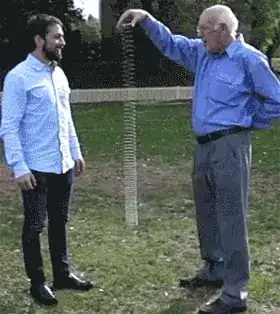Initially you hold the helical spring at one end and it is extended by the distributed gravitational force pulling it down and the reactive force of your hand holding it back on the upper end. The extension of the spring is asymmetric, because near the hand the weight causing the extension is larger. When you let the spring go, the center of gravity of it will fall with the gravitational acceleration, but the spring will contract towards its center of gravity. The initial extension is smaller below the center of gravity than above. Thus the movement of the upper end towards the center of gravity is faster than the movement of the lower end. The contraction movement of the lower end is, however, against the gravitational acceleration. Therefore, you have the impression that the upper end falls down very fast whereas the lower end stands still for a while.
